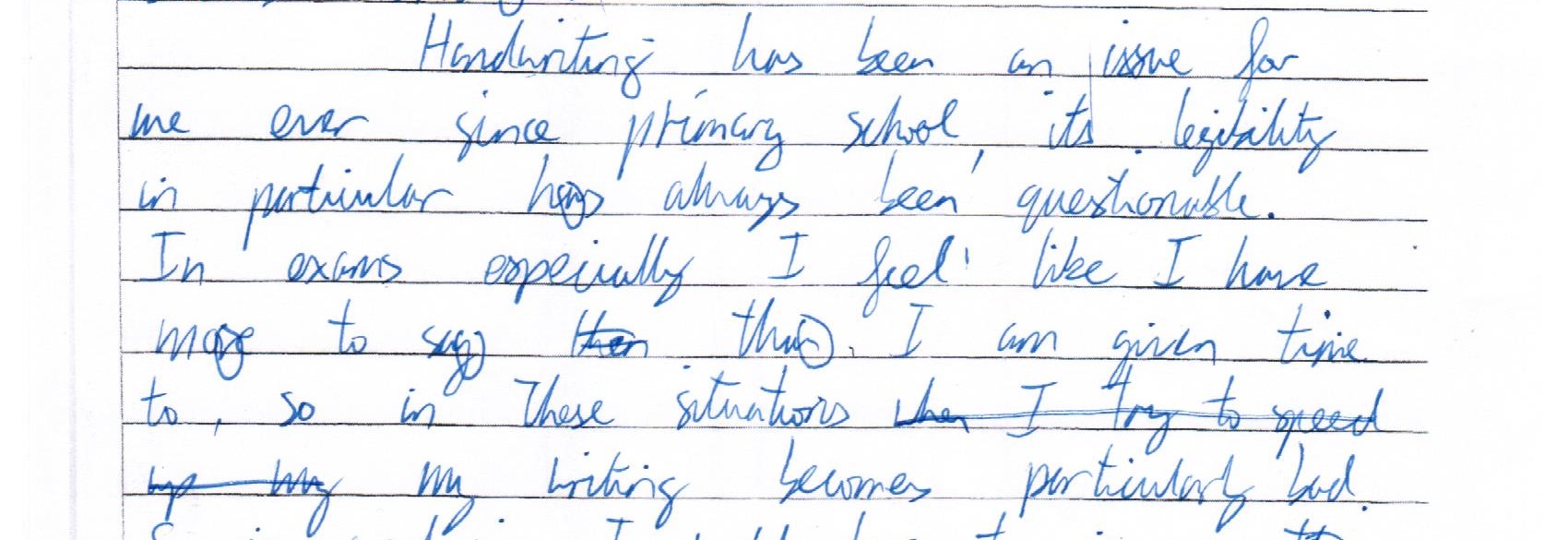I have previously written about the results achievable with Year 12 students with long standing hand writing problems, preparing for the ordeal of the HSC (ref). With these very motivated students, my specific handwriting training – employing the Cognitive Orientation for Daily Occupational Performance (CO-OP) paradigm – lead to very good results in between three and five individual sessions. I hasten to add this is not a magical process, nor is it a passive process – please see here a brief TEDx talk about the CO-OP process by Dr Helene Polatajko, one of its originators. The HSC results achieved by those three students were well-earned.
I’ve since run the program successfully in groups at Sydney schools. Here are some examples of what was achieved with a mixed group of Year 9 to Year 11 students over nine sessions. Each group member had two things in common: they have always experienced difficulties in producing legible (markable!) handwriting, and they wanted to do something about it NOW. Some could not take down notes in class which they could later read, others could not sustain legible handwriting over the duration of a written examination, others hit a wall of writing fatigue long before they ran out of things to write in exams. Many had previously had sessions with occupational therapists without success. (Please see here my views on “sensory based” therapy).
Although the sessions were conducted in a group setting, students worked individually. At the beginning of the program, each student was asked to evaluate their handwriting, and helped to identify three to five sub-goals they felt would improve their handwriting. We returned to the sub-goals each week, forming a focus for our joint work.
Student A, in Year 11, wrote with a cramped tight grip and his wrist in a hooked position which afforded poor control of the pen and led to cramping when writing for more than 10 minutes at a time. In addition, Student A identified poor letter formation and letter joins as well as inconsistent letter size as negatively impacting on the legibility of his writing and his ability to complete exams in the allocated time.

Student A completed focused, deliberate practice two to three times a week, focusing on his grip, wrist position, letter formation, letter joins and consistency of letter size. In the final session, Student A reported writing with a tripod pen grip and his wrist in a neutral position ‘automatically’. He was able to complete his assessments and exams legibly, with the increased speed and ease allowing him the opportunity to produce longer and more detailed answers, which better demonstrated his knowledge and understanding of the academic area.
Student B, in Year 9, identified inconsistent letter size, difficulty writing on the line, and poor letter joins as the main threats to the legibility of his handwriting. He was most concerned about the volume of writing he could produce, and felt that his answers lacked detail. Under the time pressure of exams, this lead to a self-defeating vicious spiral of increasing anxiety and deteriorating legibility.
In addition to weekly group sessions with me, Student B declared a commitment to least one home practice session each week, including the holidays. As you can see below, his letter size became more consistent and his letter joins became more fluid. He also reported that his handwriting speed had increased. Most importantly, he gained confidence in his ability to write quickly and legibly, and as a result his written responses became fuller and more detailed, better reflecting his knowledge of the subject.
Student C, in Year 11, identified in his writing sample poor letter formation and poor letter joins particularly in long words. His main concern was difficulty sustaining legibility when writing at speed. (Are you beginning to detect a pattern here?)
He worked hard during the group sessions, practicing correct letter formation and letter joins, and identifying where to take a break in long words, repeatedly editing his work to fine tune legibility. During the week, he made time for deliberate focused practice. As you can see below, this led to a more fluid, more legible handwriting style. Most importantly, the new style allowed greater productivity while maintaining speed.
I hope this helps illustrates that good results can be achieved even in group settings provided that:
(a) each student works independently, on their specific set of skill deficits
(b) each student has skin in the game, and is not passively following instructions from “above”, and
(c) the OT retains focus on solving each student’s specific skill deficits, rather than provide a general, generic program.
In fact, I am now thinking that the developing comradery between the students as they watched each other rapidly overcome longstanding problems, through personal effort, may be a “special ingredient” that adds to the effectiveness of group programs.






Comments are closed.